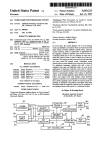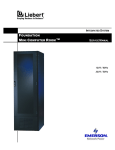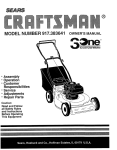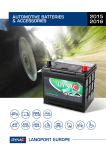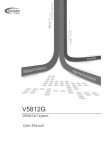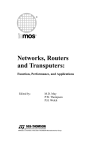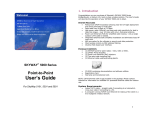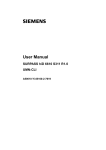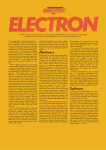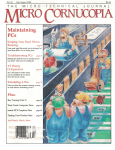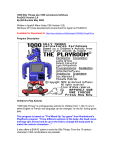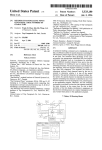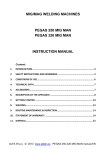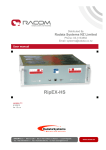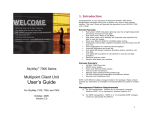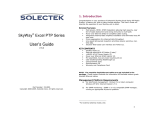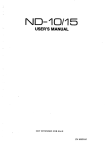Download Personal computer News Letter PLEASE note that the
Transcript
Personal computer News Letter Document Number PCN8102 November 2, 1981 Keith L. Eckhardt IBM Corporation GPO HQ Information Systems V30/G251 Santa Teresa (408) 463-3121 8+ 543-3121 VMCSTLVM3/ECKHARDT) ITPSCAAST) IBM Internal Use Only PLEASE note that the above address and phone number are NEW. IBM Internal Use only ABSTRACT This document is an IBM Internal newsletter dealing with matters of interest to users of personal computers for business reasons. It contains articles, written by the user community within IBM, that • announce programs and techniques relating to personal computers • query for existence of a program or process • describe current Work In Progress(WIP) • give early warning of problems • express an individual's point of view (letter to the editor) Articles may be submitted by anyone within IBM as long as they address one of the above areas and are not: • confidential • more than two pages in length • anonymous Opinions expressed in this newsletter are those of individuals and are not official IBM statements. This document is intended for the use of IBM employees. It may not be distributed outside of the company. It may be freely copied or transmitted to others within IBM. This document is published on the first working day of each month. Please submit your input to the editor as early as possible for editing, but not later than five working days before the end of the prior month. PCN8102 11/02/81 i i IBM Internal Use only CONTENTS Editorial 1 External Press 3 Letters to the Editor 4 contributions ••••••••••••..••••••••• 8102-01 ASYNCHRONOUS COMMUNICATIONS SOFTWARE SUPPORT 8102-02 TECHNIQUE TO SWITCH DISPLAYS VIA SOFTWARE . . .. 8102-03 QUERY FOR PC EDUCATION PLANS AND MATERIALS 8102-04 QUERY FOR MANUFACTURING APPLICATIONS FOR THE IBM PC 8102-05 IBM PC DATABASE . . . . . . . . . . . . . . . 8102-06 QUERY FOR OCR WAND CONNECTION TO IBM PC 8102-07 QUERY ABOUT PASCAL OR VISICALC PERFORMANCE 8102-08 PARTIAL RESULTS ON RGB MONITOR INVESTIGATION 8102-09 QUERY FOR PC CONNECTION TO HTAM .... 8102-10 GRAPHICS ON THE MX-80 AND MX-100 PRINTERS 8102-11 ADDENDUM TO THE VISICALC DOCUMENTATION Contents 10 10 12 13 13 13 13 13 14 15 15 15 iii IBM Internal Use only EDITORIAL This last month has been perhaps the most hectic one of my life. I have been receiving 20 to 40 calls or network messages each day since I announced the PC newsletter. The majority of the messages have been requests for the newsletter. Please check on your system to see if the newsletter is already available. Many people have agreed to be a central receiver for a node on the network; some are handling a whole site. Note that I have moved to the Santa Teresa Lab. My network addresses are still the same, but I have a new phone number. Please help the person that inherited myoId office by recording my new number and using it. SECURITY, NON-BUSINESS USE, NETWORK ABUSE There 15 very serious concern with some of the information that is being freely distributed within the company. Many people are passing rumors over the network about future announcements relating to the IBM PC. Others are sending messages that are personal business only. Neither of these activities benefit the company. I want to point out very clearly that this newsletter is for items relating to business use of personal computers. I received several things this past month that I had to reject as being of personal interest only. In the same vein, you should not be contacting contributors to this newsletter for personal reasons. Finally, this is not an IBM Club newsletter and I cannot publish anything dealing with club activities. QUES~ONS QUESTIONS QUESTIONS It is obvious that there is great interest within IBM for detailed knowledge of the IBM PC. It is also obvious that it has been hard to quickly get detailed technical information. There are some things happening that will begin to generate answers to our questions. First, the long awaited Technical Reference Manual is finally here. It has detailed information about the hardware and system software. Second, Boca Raton has established a hotline for site coordinators to use to get answers to questions. This hotline will accept both telephone and network input. They plan to build a database of Questions and Answers for on-line use. Note that the hotline is only for a few people to use, so you must forward your questions to your local coordinator. I am unsure at this point whether I can release the names of the coordinators via the newsletter. For now you will have to locate these people on your own. It will help everyone though if you DO HOT call Boca Raton to get answers to your business questions. Please use the local communication channels being set up. The "Technical Reference Manual" contains a great deal of information about the internal workings of the system. Included are logic diagrams, connectors, program interfaces, and the assembler listing of BIOS. I must point out that it is a REFERENCE manual, not an instruction manual. Some of the information is very technical and only a person familiar with this type of information will understand it. EDUCATION IS A CRITICAL NEED Education will be a big challenge over the next year. I have already contacted the San Jose education department and discussed the various options and subjects. The current thinking is to have both voluntary education and business classes starting in lQ82 on the hardware and the software packages. There can be some consolidation, also some accelerated courses such as "BASIC for Experienced Programmers". There will definitely be a need Editorial 1 IBM Internal Use only for classes for people that have never gotten involved with computing equipment before. Programmers and engineers with micro-computer experience have an excellent opportunity to show their professionalism by volunteering to teach classes to bring the newcomers up to speed. To aid in education and employee awareness, GPD will place one machine in the library at each site. Each machine will be used by the library staff part time. At lunch hour, it will be taken to the cafeteria so that every one will have some chance to see and touch it. The rest of the time it will be available for people to sign up for short individual sessions. SOFTWARE PERSPECTIVE Boca Raton has done an excellent job in choosing quality software products for the PC. I expect when new programs are announced in the future that they will be of similar quality. Note, however, that the products Boca has announced are mostly aimed at the Very Small Business user and the private user. These users operate in a stand-alone environment with occasional need to connect to a large system to search a data base. This is much different from the totally on-line environment that most of us use daily. It is my belief that we will have to write most of the software to provide the on-line functions needed within the company. There are some important points here to be discussed. First, many people are saying that true distributed processing is now possible. There is significant processing power in the IBM PC that can off-load a lot of work from the large computers. Second, applications not possible previously can now be addressed. Third, IBM does not own most of the programs offered with the PC. The implication is that we cannot make changes to the software that are needed in order to accomplish the first two points. Distributed processing is a term that is hard to define. In fact, it may be impossible because of the diverse views on it's meaning. I will use it in this document to mean multiple computers connected together, sharing data, and allowing some choice of where the data is processed. What is missing at the moment is a definition of how the big systems will interact with the little ones and what functions will be provided at each level. There are many groups throughout the company that will be developing a variety of software and hardware for the IBM PC. The development efforts I am referring to are not "official" ones from the Boca Raton Lab, but rather ones that spring up as internal organizations identify their needs. I will be contacting the site coordinators to see if a mechanism can be set up to let each group learn of competing efforts. The objective would be to reduce redundant efforts and to share ideas. While we are waiting for these efforts to complete, we should make good use of the stand alone programs that are available on the PC. A point that you must keep in mind is that most of the programs offered by Boca Raton are copyrighted by other companies. We do not have the right to make copies for distribution within the company. Every machine MUST have it's own copy of the software. NEW APPLICATION OPPORTUNITIES There are some significant new applications now possible with this machine. Some of it has to do with the price of the machine and some with the function it provides. For example, color graphics may allow us to build editors that work on pictures as well as text. The low cost printer gives the ability to print correspondence quickly and to get short items printed for desk review and markup. There is enough power in the unit to move some of the mainframe function down to the PC, freeing the mainframe of some of it's load. And there will be much more as we learn about the IBM PC in greater detail. Until next month! Keith Eckhardt PCN8102 11/02/81 2 IBM Internal Use only EXTERNAL PRESS In this section I will give abstracts of recent articles from external publications. Neither space nor copyright laws allow for the total text to be included. IBM PERSONAL COMPUTER/THE BIG BLUE GIANT MAKES ITS MOVE Creative Computing, November 1981, p.14 ""Didn't they make any mistakes?" asked one of our staff members in disbelief upon hearing our description of the new IBM Personal Computer. "Not that we could see," was the response. And, indeed, it appears that IBM has done just about everything right. " The above three sentences are part of the opening statements of a very positive article about the IBM PC. The article also promises "an in-depth evaluation in which we will let you know if, indeed, IBM has succeeded in producing the perfect personal computer." 'SB-86' CONVERTS CP/M 8-BIT SOFTWARE FOR USE ON IBM PERSONAL COMPUTER From "CO~1PUTER WORLD", Oct 19, 1981, on Page 55. It describes an operating system developed by Microsoft that is for the IBM Personal Computer. The operating system(SB-86) is designed to make IBM's personal computer compatible with "a broad range of existing CP/M software" and will be marketed by Lifeboat Associates. It facilitates running 8-bit CP/M application programs on the 16-bit IBM personal Computer. EPSON'S MX-80 - A PRINTER THAT SHOULDN'T BE OVERLOOKED. From "80 Microcomputing", August 1981, p.126 A hardware review article that explains the features of the printer. It shows the various print styles, graphics characters, and discusses programming techniques. RANGE OF SOFTWARE FOR 16-81T PROCESSORS BROADENS DRAMATICALLY From "Electronics", October 6, 1981, p.37 This article reports on interviews with Tony Gold, president of Lifeboat Associates Inc, and with Bill Gates, President of Microsoft. The article contains many comments about the IBM PC, it's software, and future offerings. External Press 3 IBM Internal Use Only LETTERS TO THE EDITOR EDITOR I had an opportunity to visit one of the Sears Business Centers in Dallas prior to their opening which actually occurred on October 14, 1981. The store was remarkably impressive; everything is prominently and attractively displayed. There are many computers that you could sit down at and exercise, and there was also what appeared to be a classroom or briefing kind of room. They were ecstatic about carrying the IBM PC and if their pre-opening queries are any indication of actual demand, IBM had better increase the manufacturing capabilities of the PC (and hopefully we will not be constrained by supplies from third party OEM vendors)! In addition to the IBM PC, they also sell the NEC PC-8001 and Vector Graphics (interestingly enough they did not have any Atari Computers which was the strong early bet for what they would be selling). They also carried Olivetti typewriters and Casto calculators as well as software, modems, modulators and miscellaneous supplies (diskettes, paper, etc.). There seemed to be at least three of each of the different "brands" of computers on display. They also had a showcase that very attractively displayed each of the adapters available for the IBM PC. They had another large display showing all of IBM's PC Software offerings. Rather than running the "rolling demo" which the local ComputerLand is doing, they have DOS up on each machine so that people can sit down and try the computer. They were also having a grand opening drawing and the prize was an IBM Personal Computer Chope I win!). The store, in some respects resembles a Bell Telephone retail store (except considerably larger and more interesting) and that isn't too surprising as the same company that set up the Bell stores set up the Sears Business Centers. As far as my limited experience goes, the Sears Business Center was the most attractive and functional computer store that I had ever been in. It definitely looks like Sears will be a very strong contender in the burgeoning small computer retail market. An interesting aspect of the Sears Business Center in Dallas is its location. It is adjacent to a Radio Shack Computer Center on one side, and two doors down is a Xerox store. My guess is that this small block of stores probably represents the greatest amount of personal computer retailing in the country. (The manager of the Radio Shack was said to welcome the Sears store with the comment that it will bring them additional business - he's probably correct but with the Sears offerings, that remains to be seen). For those of you who have never seen the packaging of software available for the IBM PC, IBM has done a superlative job. Each program comes complete with documentation and diskettes in a sturdy and attractive slip case that will make a very professional and attractive display when set up near the computer. Stan Berlin, VMCMSNVM1/BERLIN), Dallas, 8+641-7217 EDITOR, Thought you and/or your readers might be interested to know that the November 1981 issue of the U.K. magazine "Personal Computer World" contains an extensive review of the IBM PC. Although the magazine's claim that it is a "World exclusive Benchtest" may be a little exaggerated, it is certainly the most comprehensive article I've yet seen in an external publication (5 closely printed pages/ approx. 30K bytes of text). There is not much factual information that hasn't already appeared in various internal documents, but the review is full of glowing praise for all parts of the system: hardware, software and documentation. In fact I have PCN8102 11/02/81 4 IBM Internal Use Only not been able to find a single note of criticism. Their conclusion sums up the tone of the article nicely: " .... probably the most professionally put together system I have seen. lots of them look good, then you find they fall over, or the manual is unintelligible; neither is the case with this Personal Computer ••.•. In a word it's a knockout. I wish it was on sale here". That last remark echoes the feelings of myself and many European IBM'ers who are green with envy at you U.S. IBM'ers who are already able to order the PC. Keep up the good work with your newsletter - it's read with avid interest over here. Sincerely, Roger Davey, VMCUITVM1/EDUC), Uithoorn Laboratory, Netherlands. EDITOR, I wonder if you might be able to clear up some confusion, since you have worked with the IBM PC. It seems that there are at least two statements in circulation, which are contradictory. One indicates -- NO FULL SCREEN EDITOR --. The other is the Blue letter which states on page 16 under "highlights of the BASIC-80 interpreter" the indication that a -- FULL SCREEN EDITOR -- does exist. Have you seen any evidence of a full screen editor, either as a part of the base system or as an option? Your response will be appreciated. Thank You, Ray Blackmore, VMCPLKSC/C56ESRBC), Charlotte, North Carolina (EDITOR: In a word the answer is YES. There is a FULL SCREEN EDITOR facility for the BASIC language only, which the BASIC manual describes as a "screen line editor". This editor allows you to change any program line on the screen and cause it to be stored back into memory. It Is not like the full screen editors on our VM and MVS systems though, because you cannot scroll back and forth over the program. You must use the LIST command to place the program segment of interest upon the screen. It also doesn't have global find and/or replace commands. So there is NO full screen editor in the sense of a generalized file editor such as SPF and XEDIT. Easywriter has a full screen editor for its data, but it stores data on the diskettes in a unique format. This editor can only be used on Easywriter data. IBM DOS has a general data editor called EDLIN, but it is a line editor. It does have the global find ability.) EDITOR, I had a cursory look at DOS and compared it with CPM 2.2. The first impression is of great similarity. Even some of the actual commands are the same. DOS has a few niceties added: • An AUTOEXEC capability which acts like PROFILE EXEC in VM i.e. it gets automatically activated as soon the machine is turned on. This allows displaying a Menu to give directions to a naive user. • Allows editing the last line typed in using DEL, ESC, Fl etc. • Has COPY and SUBMIT memory resident speeding up greatly their performance. Letters to the Editor 5 IBM Internal Use Only • The line editor EDLIN looks the same as ED down to the individual commands. This is a disappointment as one would have liked to have had a full screen editor just as the built 1n Basic has. • There seems to be no compatibility between DOS and CPM on the IBM So files created by the one cannot be read by the other. • The only compatibility between 8080/Z80 code and IBM PC code is at Basic source code level. But I expect problems in moving a program created on Microsoft Basic on an 8080 to the IBM PC Microsoft Basic. Apart from obvious differences in handling screen commands I found subtle differences even in moving from Microsoft 4.4 to Microsoft 5.2 on the same machine. • Seattle Computer Products has a conversion program that converts Z80 Assembler code to 8086 Assembler code. Unfortunately their mnemonics are not completely compatible with Intel mnemonics. So one would need their Assembler to assemble the converted code, especially since the IBM PC does not have an Assembler announced at this time. pc. Jake Ever, VM(YKTVMV/EVER), Manufacturing Technology Institute, New York, 8+444-7287 EDITOR, I was fascinated by a copy of Vol. 1, No.1 of the IBM PC Newsletter which I got from Owego. If there is a "mailing list", please sign me up immediately. I have some questions I'd like to address to anybody who can answer them. 1. One of the letters to the editor indicated that a power-off was required to switch between the monochrome display and the color graphics card, but there was a note from the editor saying this could be accomplished in software. A number of us here are hoping to configure our machines in a fashion similar to a 3277GA/TEK 618. Or possibly, to use them for physical design sorts of applications which would require a similar configuration. The question is, can you, or can you not switch between the two display cards under program control? (EDITOR: See contributions section below.) 2. Does anybody know the maximum frequency you can get out of the built in speaker with any sort of decent resolution - and how might we find this out. Furthermore, how do you access the speaker - i.e. can you access it in a direct bit-toggle fashion which would clearly maximize your ability to control the resulting waveform .... (EDITOR: points.) Letter-to-Editor by Stan Rosenfeld addresses some of these Anyway, I think this could lead to a whole new era of programming and hardware design at IBM. It could even become fun again!! Keep up the good work on the newsletter. Lee Jones, VM(MANVM1/MPF5lFJ), Manassas, 8+725-5685 EDITOR, Using the BIOS listing in the technical reference manual, I mapped a few of the characters for the graphics adapter, not the IBM monochrome display/printer adapter. I understand that the BIOS listing contains the mapping of the first 128 characters which can be used when the graphics adapter is in graphics mode. I have several comments and questions about the characters: PCH8102 11/02/81 6 IBM Internal Use only 1. As you can see from the mapping which follows, lower case characters with descenders hit the last line of the character box and upper case characters hit the top line of the character box. Thus, lower case characters like g, q, y and j will merge with upper case characters and lower case characters with ascenders like f and j. That is, the characters in these situations will merge together with no vertical spacing between lines. 2. Are the characters used when the graphics adapter is in text mode the same as those mapped in the BIOS listing? 3. Notice that the q and g are the same except for the last line. What happens when the cursor is below these characters? 4. I would expect all caps to be very readable but there would never be more than one vertical scan line between characters. This is easily verified by noticing a 00 in the last byte of every capital letter and a non-OO in the first byte of every capital letter. The display when using all caps, typical of most programming languages, would appear too close together. 5. Here is the mapping of a few of the characters. The choices illustrate some of the worse case situations. 1 2 1 2 3 456 7 8 1 2 3 456 7 8 1 2 345 6 7 8 XX XX X X 3 X X 4 X X X X X X 6 X X X X 7 XX XX 5 XXXXXX 8 1 XXXXXXX 2 XX X 3 XX X 4 X X X X X 5 X X 6 X X 7 XXXX 8 xXX XX XX XX X X XX XXXXX XX XXXXX XX X X X X x X X XX XX XX X X X X X XXX XX XX X X XX XX XXXXX X X XXXX X XX XX XX XX XXXX XX XX XXXX In summary, if you want excellent text characters you must get the IBM monochrome display. If you want to do all-points-addressable graphics you must get the Graphics adapter. It is too bad that one adapter can't be used for both purposes. Jim Gilliam, VMCPLKSK/K58PJHGC), Poughkeepsie EDITOR Congratulations on taking initiative in starting this interest group and providing a forum for discussion about the IBM PC. My own interest stems from having my own micro-system already, a UK-designed and made NASCOM 2 system based on the Z80A chip. However, the IBM PC has a very interesting specification and myself (and many others) are awaiting it's launch in Europe. Following your own article (item 8101-04), I think that all development groups working with network software or hardware should have priority in getting experience with the IBM PC. My own group develops and maintains the software used in the EMEA network, together with business communications applications. I think the cost advantages of using the IBM PC must be enormous when used to perform editing and other off-line preparation work (such as preparing mail for sending to ETSt VNET, ITPS etc.) which will reduce cpu utilisation and line loadings. Letters to the Editor 7 IBM Internal Use only Finally, I only got to hear about your Newsletter from a friend who knew someone else, etc . . . How about an advertisement in the VM and MVS Newsletters to spread the word? (EDITOR: The PC Newsletter was announced in the MVS and Small Systems newsletters on 9/15, was submitted to the VM newsletter on the same date.) Also I would like to be on your dlstribution list for the Regards, Newsletter. Roger Lee, VMCRESPOND/LEE), Respond - Network Services group, Portsmouth, England HELLO FROM BOCA: This is being written on an IBM PC dialed in to VM! I thought PCN readers might like to hear a little about Boca as well as perhaps a few PC hints and kinks. I've been here two weeks now (on loan from San Jose) with another few days to go. Jim Shumacher and I have been setting up a hotline/hub for the use of PC site coordinators. The atmosphere here is joyous, but still very, very busy!! Despite their very heavy load of work, most everyone is keeping their cool and helping us where they can. Here are some "goodies" you may find useful. For those of you who don't have your systems yet, put this newsletter away for later. The light pen you need to start looking for has to work at TTL levels, where the detection of light produces a change from 5 volts to a volts. The joysticks as specified in the TRM (doesn't everyone have a Technical Reference Manual yet?) are to contain dual lOOk ohm pots. You will probably see some disk directory entries without dates. This occurs when a file is created without the DATE command having been used. It is automatically called when DOS is booted, UNLESS an Autoexec program exists. The solution is to issue the date command yourself or, more permanently, add the DATE command to your batch (Autoexec'd) program. Don't forget, when DEF SEGing to BOOOO, or wherever, to drop a example, DEF SEG=BOOO. '0'. For The Asynch adapter requires a cable of your own making. You will see different instructions telling which wires need to be run from end to end. One communications program may use less lines than another. My recommendation is to make or find a cable with all pins wired. This may be overkill, but removes another worry. Don't put your TV set close to the disk drives. Guess why. (EDITOR: A minimum of 10 inches is recommended to keep from zapping your diskettes.) You can program your own characters (128 of them) if you have the color graphics adapt. See TRM A-59 and A-75. Good news!! The games adapter can double as a general purpose analog to digital input card. See TRM 2-117 for 'how to' info. More good news. locate function, to execute EDLIN save your program Although BASIC screen editor doesn't contain a find or EDLIN does. But don't make the mistake I did, which was against a vanilla copy of my BASIC program. You must with the ASCII option and use EDLIN against that copy. Those of you who have been reading code (in ComputerLand?) may have noticed the strange poke 106,0. This is generally useful for clearing the keyboard buffer when you don't want 'leftover' characters to be read in to your program. But it's also currently being used to 'fix' a (rather minor) bug. Namely, when a programmed function key is the last key used before an INKEY$ is executed (such as when a program is started with the RUN function key), a hang condition occurs when the the last character is PCN8102 11/02/81 8 IBM Internal Use only read in. Poke 106,0 to the rescue. And some not so good news .•. If you have tried to stop an LLIST (in Computer Land again?) you know i t doesn't want to stop! There is a way, and that's the bad news. Turn off the printer and wait for it to time out (about 10 seconds)! Back to good (and fun) things. As advertised, the IBM PC has but one voice. (EDITOR: The number of voices refers to the number of sounds or tones that can be produced simultaneously. It takes multiple voices to produce harmony.) HOWEVER the TRM describes three(3) ways to simultaneously generate waveforms to the speaker! A little judicious coding is called for. Who's going to be the first???(TRM 2-5) I have some more but I feel this is getting a little long for the Newsletter. More next time. stan Rosenfeld, VMCSTlVM3/ROSENFEL), Santa Teresa, 8+543-3690 Letters to the Editor 9 IBM Inte~nal Use Only CONTRIBUTIONS 8102-01 ASYNCHRONOUS COMMUNICATIONS SOFTWARE SUPPORT This document attempts to answer the most frequently asked questions about the Asynchronous Communications Support program (or Communications Program, for short) for the IBM Personal Computer. Question Will an IBM Personal Computer with the replace a 3101? Communications Program Ans"le~ The Communications Program provides most of the straight terminal features of the 3101. It does not support the escape sequences (ESC character plus graphics) that permit a host system to control the cursor position on a 3101. It does not support 3101 block mode. If you are using a 3101 to log into a system as a plain ASCII terminal (the equivalent of a model 33/35 Teletype), you can use the IBM Personal Computer with the Communications Program. If you are connected to a system that utilizes the 3101 escape sequences (such as the Yale IUP running on an IBM Series 1), you cannot use the Communications Program. Question What can I upload and download? The Upload and Download functions operate with VM/370 and TSO. Most files of textual material (for example, a memo or a program source file) can be Uploaded and Downloaded. There are restrictions on the length of file lines (records) that can be transferred. For example, lines longer than 130 characters cannot be uploaded. See the User's Manual for other restrictions. Question What error checking is done during Upload and Download? Answe~ It is possible to have the system perform parity checking on characters during upload or download, provided the host system support this checking. A Compare function is provided by which a host system file can be compared against a file on the Personal Computer. Question How do Upload and Download work? Answe .... Upload and Download use the VM/370 (CMS) and TSO editors for file transfers. The Communications Program simulates a terminal user using one of these editors. For uploading, the program accesses the host editor, puts the editor into input mode and then transmits lines one at a time to the editor. For downloading, the program accesses the host editor and then lists the lines in the host file one at a time. This method of file transfer means that no special program (or execs) are needed on the host system. However~ it permits upload and download to function only with TSO and VM/370. Question PCN8102 11/02/81 10 IBM Internal Use Only Can I transfer files between IBM Personal Computers? Answer Yes, a straightforward method of communication between IBM Personal Computers is provided. Once this communication is established, one user can select a function that transmits a file and the other can select a function that receives a file. Once these functions are selected and the file names specified on each IBM Personal Computer, file transfer is automatic. Quest;on Can I transfer files from other personal computers to an IBM Personal Computer? Answer Yes, the protocol used for transfer of files between IBM Personal Computers can be used with non-IBM personal computers. This protocol is described in the User's Manual. It is necessary to write a program for the non-IBM personal computer to handle the transfer protocol. In most cases this program can be written in BASIC. We have successfully transferred files to and from an APPLE II. Quest;on What kind of a cable will I need to connect my IBM Personal Computer to an modem or host system? Answer The cable to connect the Asynchronous Communications Adapter on your IBM Personal Computer to a modem or a host system uses the RS-232-C EIA signal standards for data interchange. The cable should have a female connector on the end that connects to the IBM Personal Computer and an appropriate connector (usually male) to connect to the modem or host system cable. These connectors are D Subminiature 25 pin connectors. At least the following wires (2, 3, 4,5, 6, 7,8,20) should be connected from the connector on one end to the connector on the other. If other wires are connected, they should not affect operation. Question What line speeds are supported? Answer Line bit rates of 75, 110, 150, 300, 600, 1200 and 1800 bits/second are completely supported. At 2400 bits/second, the Program will operate correctly as a terminal except buffer overflows may occur when listing some files at the terminal. Operation at 4800, and 9600 bits/second 1S also possible, but difficulties may be experienced during terminal operation. However, no loss of data should occur during file transfers (e.g., Downloading a file) at any of the above line speeds. Question What type of modems can be used? Answer Any Full Duplex start/stop modem or acoustic coupler compatible wi th the RS-232-C S1 gnal standard can be used. Modems us; n9 a Half Duplex line protocol cannot be used. Question Is a Break Key provided? Contribut;ons 11 IBM Internal Use Only Answer Yes. During terminal operation, pressing the Fl produces a BREAK signal on the communication line. Function Key Question Will the program be the basis for 3270 function? Answer No. Question Will the program spool terminal I/O? Answer No. Only the 24 lines of text displayed on the screen are retained. A user change to the BASIC portion of the Communications Program would be necessary either to keep more lines in memory or as a file. Question Can I access the SOURCE and DOW JONES systems? Answer Yes, terminal parameters can be specified for the Communications Program that permit access to these systems. Can I print out what I receive as a terminal? Answer Yes, the Print Screen key on the IBM Personal Computer permits you to print the contents of the screen at any time you are operating as a terminal. Frank Bequaert, IBM Cambridge Scientific Center 8102-02 TECHNIQUE TO SWITCH DISPLAYS VIA SOFTWARE The demonstration package that DPD has been given uses the following sequences to switch adapters: 10 20 30 40 50 REM SWITCH TO MONOCHROME ADAPTER DEF SEG=O POKE &H410,CPEEK(&H410) OR &H30) DEF SEG LOCATE 1,1,12,13 10 20 30 40 50 REM SWITCH TO COLOR/GRAPHICS ADAPTER DEF SEG=O POKE &H410,(PEEK(&H410) AND &HCF) OR &H20 DEF SEG LOCATE ,,1,6,7 I have used the above sequences personally to switch between the displays. I found that I had to keep track of the cursor position independently for each display. The first two fields of the LOCATE statement are the row and column for the next output and can be used to force cursor placement. Keith Eckhardt, VM(STLVM3/ECKHARDT), Santa Teresa, 8+543-3121 PCN8102 11/02/81 12 IBM Inte~nal Use only
















